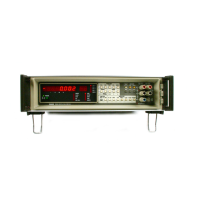Go To Local-Lock
Out Remote (cont)
The state of
the instrument,
when changing
from
remote to local
operation will
be modified as
follows:
1,
Ohms fast mode will
be
ignored.
2. Scaling mode will not be in effect
(8500A only).
$
3. If the high averaged
samples
per reading rate
was in effect, the
samples per reading will
be set to 2
7
(8500A only).
The state of the instrument
when changing from
local
to remote operation
will be modified as follows:
1. Ohms fast mode
(Z1) and continuous reading
mode will be resumed iftheDMM
was in either mode
when
place into local.
2. Any error
that occurred during local
operation
will
be
stored and
available for recall.
c
—
j
High
Speed Reading Mode
$
The
"I"
character
can be
used
with
the Parallel
interface {Option
-07) (and with the IEEE-488
Interface
Option
-05
in the 8502A only).
The High
Speed
Reading
mode provides
a shortened
3-byte binary two’s
complement
format response
representing the
input to
the DMM’s A/D Converter.
Speeds up to 500 readings
per second are possible
in this mode of operation.
True readings can
be computed from
this response
using range and function
dependent factors
{refer to
Fluke Application Bulletin
25).
The High Speed Reading
mode is suited
to systems
with very
fast processors,
to use
with
stored readings,
or to applications not requiring
direct numeric
conversions
(e.g., zero crossings or large
deviations
from a nominal value).
Use of the
"!"
character
will place the
DMM in the High
Speed Reading mode
and trigger the first
reading.
Subsequent readings can
be
triggered
by sending
the
"?"
character.
In addition, for the
8502A equipped with
the -08A Option,
subsequent readings
can be triggered
by sending the TTL
pulse with the External
Triggering
Mode
("Q"
or
"Q1").
The High Speed Reading
mode
can be aborted
at any
time
by transmitting
a character
other
than
"?"
when
a
reading
is to be triggered.
The
character
sent in this
case will do nothing
more than
cause
the DMM to exit the High
Speed Reading
mode.
2A-5

